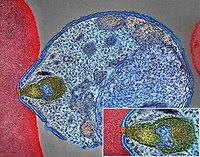
Photo from wikipedia
Background: Proguanil is currently the recommended drug used for malaria chemoprophylaxis in children with Sickle cell anaemia (SCA). Aims: This study aims to determine the uptake and usage of proguanil… Click to show full abstract
Background: Proguanil is currently the recommended drug used for malaria chemoprophylaxis in children with Sickle cell anaemia (SCA). Aims: This study aims to determine the uptake and usage of proguanil as malaria chemoprophylaxis and the socioeconomic determinants of its usage in children aged 6–59 months. This was a descriptive cross-sectional study carried out in two major sickle cell clinics in Benin City, Edo state, Nigeria. A total of 420 participants were interviewed using semistructured questionnaires. Patients and Methods: Descriptive, bivariate, and multivariate analysis of quantitative data were done using SPSS version 21. Results: The uptake of proguanil among study participants was 67.4%; of these number, 268 (94.7%) reported daily use of proguanil. Only 3 (0.7%) used pyrimethamine as chemoprophylaxis, while 134 (31.9%) used no form of malaria chemoprophylaxis. Having mothers with higher level of education (LOE) (P = 0.013, odds ratio [OR] = 1.91, 95% confidence interval [CI] = 1.15–3.17), attending clinic at the University of Benin Teaching Hospital (UBTH) (P = 0.044, OR = 2.15, 95% CI = 1.02–4.54), older age group (36–59 months) (P = 0.015, OR = 1.67, 95% CI = 1.11–2.51), and owning insecticide-treated net (ITN) (P = 0.000, OR = 3.11, 95% CI = 1.98–4.88) were significant positive predictors for the usage of proguanil. Conclusion: Proguanil uptake was low. Attending sickle-cell clinic at UBTH, having mothers with tertiary LOE, and owning ITN were social factors associated with high usage of proguanil amongst children with SCA. Continuous monitoring and evaluation of the uptake and usage of proguanil in children is important, so as to aid policy implementation and review.
Journal Title: Nigerian Journal of Clinical Practice
Year Published: 2022
Link to full text (if available)
Share on Social Media: Sign Up to like & get
recommendations!